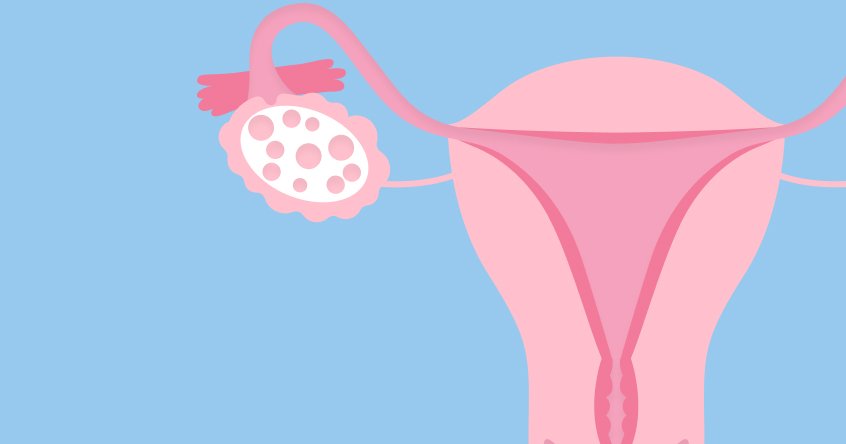Polycystic Ovary Syndrome (PCOS) and uterine fibroids are two common reproductive health issues affecting many women worldwide. These conditions can significantly impact a woman’s quality of life, fertility, and overall well-being. In this comprehensive guide, we will delve into the causes, symptoms, and various treatment options available for PCOS and fibroids, emphasizing a holistic approach to managing these conditions.
Contents
How are PCOS and Fibroids Connected?
Polycystic Ovary Syndrome (PCOS) and uterine fibroids are both common reproductive health conditions that affect women, but they are distinct disorders with different characteristics. While they may coexist in some cases, there isn’t a direct causal relationship between PCOS and fibroids. However, there are some indirect connections and shared risk factors that can contribute to their occurrence in the same individual.
Hormonal Imbalances:
- PCOS is primarily characterized by hormonal imbalances, including elevated levels of androgens (male hormones) and insulin resistance. These hormonal disruptions can affect the menstrual cycle, ovulation, and fertility.
- Uterine fibroids, on the other hand, are noncancerous growths of the uterus that are influenced by estrogen and progesterone levels. Hormonal fluctuations, especially during reproductive years, can contribute to the development and growth of fibroids.
Insulin Resistance:
- Insulin resistance, a key feature of PCOS, can lead to elevated insulin levels in the bloodstream. Insulin is known to stimulate the production of androgens, contributing to the hormonal imbalances seen in PCOS.
- Elevated insulin levels may also promote the growth of uterine fibroids. Some studies suggest a potential link between insulin resistance and the development of fibroids.
Shared Risk Factors:
- Both PCOS and fibroids share certain risk factors, such as obesity. Obesity is associated with insulin resistance and hormonal imbalances, making individuals more susceptible to both PCOS and fibroids.
- Genetic factors may also play a role in the development of both conditions. If a woman has a family history of PCOS or fibroids, her risk of developing either condition may be increased.
Menstrual Irregularities:
- PCOS often leads to irregular menstrual cycles, anovulation (lack of ovulation), and heavy or prolonged periods. These menstrual irregularities can contribute to the development of fibroids over time.
While these connections exist, it’s important to note that not every woman with PCOS will develop fibroids, and vice versa. Additionally, many women with either PCOS or fibroids have successful pregnancies and manage their conditions effectively.
Different PCOS and Fibroids Treatment Options
Here’s an alternative overview of treatment options for both Polycystic Ovary Syndrome (PCOS) and uterine fibroids:
Lifestyle Modifications

Lifestyle modifications play a crucial role in managing both Polycystic Ovary Syndrome (PCOS) and uterine fibroids. Here are some lifestyle changes that can be beneficial:
Healthy Diet:
- PCOS: Focus on a balanced diet with an emphasis on whole foods, lean proteins, fruits, vegetables, and whole grains. Limit processed foods, sugars, and refined carbohydrates.
- Fibroids: Incorporate foods rich in antioxidants, such as fruits, vegetables, and whole grains. Some studies suggest that a diet high in fruits and vegetables may have a protective effect against fibroids.
Weight Management:
- PCOS: Maintaining a healthy weight is crucial for managing PCOS symptoms. Weight loss, even a modest amount, can improve hormonal balance and regulate menstrual cycles.
- Fibroids: Obesity is associated with an increased risk of fibroids. Achieving and maintaining a healthy weight may help manage symptoms.
Regular Exercise:
- PCOS: Engage in regular physical activity, including both aerobic exercises and strength training. Exercise can help improve insulin sensitivity, manage weight, and regulate menstrual cycles.
- Fibroids: Regular exercise can contribute to overall well-being and may help control weight, reducing the risk of fibroids and managing symptoms.
Stress Management: Chronic stress can exacerbate symptoms. Incorporate stress-reducing activities such as meditation, yoga, deep breathing exercises, or mindfulness practices.
Adequate Sleep: Ensure you get enough quality sleep each night. Poor sleep can affect hormonal balance and overall health.
Limit Alcohol and Caffeine: Moderate alcohol intake and limit caffeine, as excessive consumption can impact hormonal balance and exacerbate symptoms.
Hydration: Stay well-hydrated by drinking plenty of water. Proper hydration supports overall health and may help with symptom management.
Quit Smoking: Smoking is associated with an increased risk of both PCOS and fibroids. Quitting smoking can have numerous health benefits.
Medications

Medications play a significant role in managing symptoms associated with both Polycystic Ovary Syndrome (PCOS) and uterine fibroids. Here are common medications used for each condition:
Polycystic Ovary Syndrome (PCOS):
Oral Contraceptives (Birth Control Pills):
- Purpose: Regulate menstrual cycles and reduce androgen levels.
- Benefits: Control menstrual irregularities, reduce acne, and manage excessive hair growth.
Anti-Androgen Medications:
- Examples: Spironolactone, flutamide, and finasteride.
- Purpose: Counteract the effects of elevated androgen levels, addressing symptoms like acne and hirsutism (excessive hair growth).
Metformin:
- Purpose: Address insulin resistance, which is often associated with PCOS.
- Benefits: Helps regulate menstrual cycles, improves insulin sensitivity, and may aid in weight management.
Ovulation Induction Medications:
- Examples: Clomiphene citrate, letrozole.
- Purpose: Stimulate ovulation for women trying to conceive.
GnRH Agonists or Antagonists:
- Purpose: Regulate menstrual cycles and manage symptoms.
- Benefits: Can be used in certain cases to induce a temporary state of menopause to regulate hormonal levels.
Uterine Fibroids:
Non-steroidal anti-inflammatory Drugs (NSAIDs):
- Examples: Ibuprofen, and naproxen.
- Purpose: Relieve pain associated with fibroids.
Tranexamic Acid:
- Purpose: Reduce heavy menstrual bleeding by helping blood clot more easily.
Selective Progesterone Receptor Modulators (SPRMs):
- Example: Ulipristal acetate.
- Purpose: May be used to manage symptoms of fibroids, such as heavy bleeding.
Aromatase Inhibitors:
- Purpose: Inhibit the production of estrogen, potentially slowing the growth of fibroids.
- Usage: Usually considered for postmenopausal women or in combination with other treatments.
Uterine Artery Embolization (UAE):
- Purpose: Blocks blood flow to the fibroids, causing them to shrink.
- Usage: Non-surgical procedure for symptom relief.
Fertility Treatments
Surgical Options
Surgical options for individuals with Polycystic Ovary Syndrome (PCOS) and uterine fibroids differ based on the nature of each condition.
- PCOS typically does not necessitate surgical intervention; however, in certain cases where fertility is a concern, ovarian drilling may be considered as a procedure to stimulate ovulation. On the other hand, uterine fibroids offer several surgical options.
- Myomectomy involves the surgical removal of fibroids while preserving the uterus, making it suitable for individuals desiring fertility preservation.
- Alternatively, for those not concerned with fertility or experiencing severe symptoms, a hysterectomy may be considered, involving the removal of the uterus.
The choice of surgical intervention depends on the specific circumstances, symptoms, and reproductive goals of the individual, and it is crucial to consult with healthcare professionals to determine the most appropriate course of action.
Non-Invasive Procedures
Non-invasive procedures offer viable options for managing symptoms associated with both Polycystic Ovary Syndrome (PCOS) and uterine fibroids.
- In the context of PCOS, while there are limited non-invasive procedures specific to the condition, lifestyle modifications, medications, and fertility treatments often serve as primary approaches. For uterine fibroids, non-invasive procedures are more prominent.
- Uterine artery embolization (UAE) is a non-surgical intervention that involves blocking the blood supply to fibroids, leading to their shrinkage.
- Similarly, MRI-guided focused ultrasound surgery employs ultrasound waves to target and destroy fibroids without the need for surgery.
These non-invasive procedures can provide effective relief from symptoms associated with fibroids, offering alternatives to traditional surgical interventions. It is crucial to consult with healthcare professionals to determine the most suitable non-invasive approach based on individual circumstances and preferences.
Endometrial Ablation
Endometrial ablation is a medical procedure primarily indicated for managing heavy menstrual bleeding and is not a targeted treatment for either Polycystic Ovary Syndrome (PCOS) or uterine fibroids.
In cases where women with PCOS experience heavy or irregular menstrual bleeding, endometrial ablation may be considered to alleviate this symptom.
However, it does not address the underlying hormonal imbalances associated with PCOS. Similarly, for uterine fibroids, endometrial ablation may be an option to reduce heavy bleeding, but it does not target the fibroids themselves.
Individuals with PCOS or fibroids must consult with their healthcare providers to determine the most appropriate treatment plan, considering their specific symptoms, reproductive goals, and overall health.
Sources To Get PCOS and Fibroids Treatment

When seeking information and treatment options for PCOS and fibroids, it’s important to rely on reputable sources and consult with healthcare professionals. While online resources can provide valuable information, they should complement, not replace, personalized medical advice. Here are some reputable online providers and sources where you can find information and support:
- HerMantra: HerMantra offers comprehensive and reliable information on various medical conditions, including PCOS and fibroids.
- WebMD (webmd.com): WebMD is a widely recognized online health information source that provides articles, expert advice, and community forums.
- American College of Obstetricians and Gynecologists (ACOG) (acog.org): ACOG’s website offers patient education resources on women’s health, including information on PCOS and fibroids.
- National Institute of Child Health and Human Development (NICHD) (nichd.nih.gov): NICHD, part of the National Institutes of Health (NIH), provides research-based information on various reproductive health issues.
- PCOS Awareness Association (pcosaa.org): This nonprofit organization focuses on raising awareness about Polycystic Ovary Syndrome and offers resources for individuals seeking information and support.
- Fibroids Network (fibroids. network): Fibroids Network is an online platform that provides information and support for individuals dealing with uterine fibroids.
- Healthline (healthline.com): Healthline offers medically reviewed articles, expert advice, and community forums covering a wide range of health topics, including PCOS and fibroids.
Always remember to consult with your healthcare provider for personalized advice and treatment recommendations based on your specific health condition and needs. Online information can be a valuable starting point for understanding these conditions, but it should not replace professional medical guidance.
Conclusion
In conclusion, managing Polycystic Ovary Syndrome (PCOS) and uterine fibroids requires a multifaceted approach, considering the unique characteristics of each condition.
Individuals must collaborate closely with healthcare professionals to devise a personalized treatment plan that aligns with their health goals, ensuring comprehensive and effective management of PCOS and fibroids. Online resources from reputable providers complement this process, offering valuable information and support, but should not replace the guidance of healthcare professionals in making informed decisions about treatment options.
If you are facing PCOS-related issues, PCOS treatment at HerMantra can help. Book your free trial online Pcos treatment session now.


